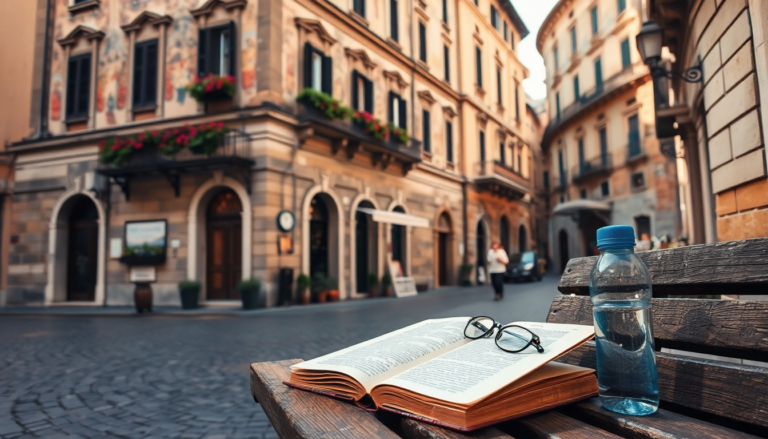Argomenti trattati
Wandering through Rome is like stepping into an enchanting film set, where every corner tells a story waiting to be uncovered. The city, steeped in history and culture, offers a unique backdrop that has inspired countless writers and filmmakers. One such literary gem is “La storia” by Elsa Morante, a novel that intricately weaves the fabric of post-World War II Rome into its narrative. As you stroll through the streets of this timeless city, you can immerse yourself in the world of Morante’s characters, experiencing the struggles and triumphs that unfold against a backdrop of historical events.
San Lorenzo: The heart of Morante’s narrative
San Lorenzo, a vibrant neighborhood, serves as the initial setting for Morante’s tale. Here, the central character, Ida, navigates her life as a single mother with her two sons in a modest apartment. This area, characterized by its distinctive ring houses, holds a significant place in Rome’s contemporary history. Notably, it is where Maria Montessori established her first Casa dei Bambini, a pioneering educational institution.
The haunting memories of July 1943 still resonate within San Lorenzo, as it was the site of the Allies’ first bombing during World War II. This tragic event leads to the destruction of Ida’s home, forcing her and her children to seek refuge elsewhere. As you walk through this neighborhood, holding Morante’s novel, the narrative unfolds vividly, allowing you to empathize with the characters’ plight amidst the chaos of war. The Basilica di San Lorenzo fuori le mura, dating back to the 4th century, and the ancient Porta Tiburtina stand as testaments to the area’s rich history.
Pietralata: A refuge in turmoil
As the story progresses, Ida and her son Useppe find themselves in Pietralata, a neighborhood that reflects the struggles faced by many during that tumultuous period. The communal living conditions they endure, sharing a room with a diverse group of individuals, highlight the resilience of the human spirit in the face of adversity. Through Morante’s words, readers witness the transformation of their lives as they adapt to their new environment.
Pietralata’s historical significance extends beyond its representation in literature. The area became a focal point for many post-war narratives, including those by Pier Paolo Pasolini, who also captured the essence of life in this neighborhood. While exploring Pietralata, you might come across religious buildings and the studios where renowned filmmakers like Federico Fellini crafted cinematic masterpieces, blending the arts with the everyday struggles of its residents.
Testaccio: A vibrant community
The narrative takes another turn as Ida and Useppe move to Testaccio, a lively district known for its rich culinary heritage and cultural significance. Sharing a rented room in the Marrocco family’s home, they encounter a whirlwind of characters that add depth to their story. It’s in Testaccio that Morante’s experiences as a child resonate, as she spent her formative years in this very neighborhood.
Testaccio is dotted with reminders of its historical roots, from the iconic Mattatoio, now a cultural center, to the striking Pyramid of Cestius, a testament to Rome’s diverse architectural influences. As you explore this area, consider how Morante’s memories intertwine with the present, creating a tapestry of life that reflects both past and present.
The Jewish Ghetto: A somber reflection
Although the characters of Morante’s novel do not reside in the Jewish Ghetto, it plays a pivotal role in the narrative. This neighborhood becomes a symbol of suffering and loss during the Holocaust, particularly when Ida and Useppe witness the train bound for Auschwitz at Tiburtina station. The Ghetto, rich in history and culture, invites exploration, offering a glimpse into the resilience of a community that has endured much.
As you navigate through the Ghetto’s ancient streets, the remnants of its past blend seamlessly with contemporary life, creating a unique atmosphere that reflects both joy and sorrow. The flavors of traditional Jewish cuisine tantalize your taste buds, providing yet another layer to this complex neighborhood.
A journey through time
Traveling through the neighborhoods depicted in Morante’s “La storia” allows for a deeper understanding of Rome’s historical and emotional landscape. Each area, with its rich stories and vibrant character, offers a glimpse into the lives of those who have walked these streets before. While the city has transformed over the years, the essence of Morante’s narrative continues to resonate, inviting travelers to connect with the past while embracing the present.
In the end, your exploration of Rome’s hidden corners becomes not just a journey through the city, but also a journey through literature, history, and the human experience. With each step, you uncover layers of meaning that enrich your understanding of both the city and the timeless stories that shape it.

